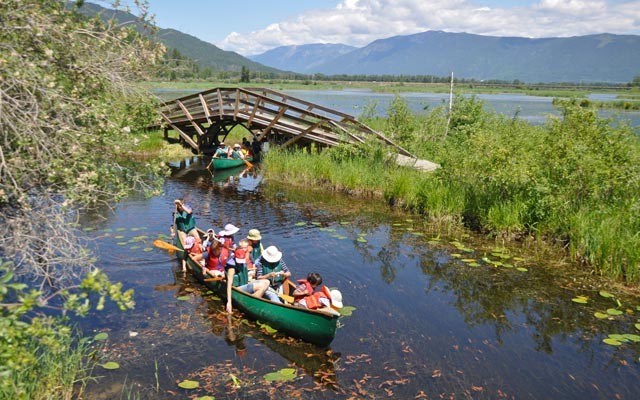As the crow flies, there's no more direct route across southern B.C. than the highway that bears the black-beaked bird's name.
A Fraser Valley farmland gives way to mountain ranges at Hope, the western terminus of the transprovincial Highway 3, or Crowsnest Highway, which runs 1,161 kilometres to Medicine Hat in southeastern Alberta.
Already a popular route with travellers — and bootleggers — well before its official debut in 1932, the winding Crowsnest plays footsie with the Canada–U.S. border for much of its span. With lighter traffic volumes, B.C.'s 837-kilometre section offers a more leisurely alternative to the Trans-Canada Highway.
Contemplating a summer trip along the Crowsnest? Here are three must-sees along the way as road-tested by Pique.
Respites from sunbaked asphalt don't come much handier than in the open subalpine meadows traversed by the Heather Trail in E. C. Manning Provincial Park, partway between Hope and the copper-mining town of Princeton. And finding your way to where cool breezes fan a profusion of alpine blossoms just got easier, thanks to a new recreation and backcountry topographic map (Manning Park and Skagit Valley Park [Clark Geomatics, $9.95]), the first such offering on these twinned protected areas in 20 years.
By phone from North Vancouver, cartographer Jeff Clark singled out the meadows as his favourite spot in the vastness of the 70,844-hectare Manning, which is bisected by the Crowsnest. "Two or three turns up Blackwall Road across from Manning Park Lodge on Highway 3 and you're there. It's harder to beat than anywhere around here — around the province, for that matter — with views into Washington of jagged North Cascade peaks."
Nuggets of helpful trail tips and historical footnotes stud the seemingly three-dimensional contours of the map's realistic rendering, the latest in a series of four such pocket-sized, waterproof, and tear-resistant publications. Clark said that his previous diagrammatic representation of Garibaldi Provincial Park garnered praise from a National Geographic editor as "the best map to come out of Canada in 50 years".
Recent highway upgrades notwithstanding, vehicle passengers on the Crowsnest must still brace themselves where the road winds through a set of double-radius hairpin turns west of Princeton. After surmounting this section, or to quiet the mind in advance of the challenge, pull off at Bromley Rock Provincial Park, where the Similkameen River's undulating course mimics the land route.
A striking granite bluff shoves the shallow river into a standing wave, perfect for bodysurfing or boogie boarding. With the possible exception of the public beach in downtown Osoyoos (two hours farther east), swimming in fresh water beside the Crowsnest is nowhere more accessible than here in the shade of an old-growth Douglas fir forest.
Along with fresh water, shade is a summer traveller's most welcome boon. Combine the two — as along the 32 kilometres of trails and boardwalks that interlace tall stands of black cottonwoods and fan out through the Kootenay River wetlands in the Creston Valley — and you have an unbeatable synergy.
Where the Crowsnest climbs through the Kootenays between Cranbrook and Castlegar, turn in at the Creston Valley Wildlife Management Area's interpretive centre and take a cool stroll. Better yet, hop aboard one of the centre's voyageur canoes for an hour-long paddle tour of the mud-diked channels, where one of the largest concentrations of bird species in North America is on display.
That's where Pique met up with education and communications coordinator Andrea Chapman. The 29-year-old naturalist said she had landed her "dream job" after completing studies in recreational fish and wildlife management at Thompson Rivers University in Kamloops.
"People come here with their birding life lists, especially from Switzerland and Germany, where they get lots of time off to pursue their hobby," she said while gazing out from one of the centre's observation towers across vast floating mats of cattails, water lilies, marsh marigolds, and invasive yellow-flag irises. As silent proof of Chapman's assertion, almost every other person appeared to be toting a spotting scope.
Chapman related how the Kootenay River had been diked to create farmland as well as sustain an approximately 7,000-hectare parcel of priceless habitat for more than 250 nesting and migratory avian species — such as trumpeter swans, American white pelicans, and turkey vultures — as well as reptiles such as western painted turtles, which lay their eggs in the gravelled courses of four creeks that flow into the wetland around the interpretive centre. Bales of turtles could easily be seen basking on logs throughout the wetland. "Plan on taking 70 minutes or so to complete a circuit of the marsh," advised Chapman. "Keep your eyes open. Wetlands have the greatest concentration of biodiversity per square foot than any other ecosystem. There's always something surprising to see, such as a family of great horned owls or members of a huge herd of resident elk who stay in the reserve."
That's something to crow about.
Access: E. C. Manning Provincial Park lies 340 kilometres southeast of Whistler. For details on the Manning Park and Skagit Valley Park map, visit www.clarkgeomatics.ca. Creston is 860 kilometres east of Whistler. For information on the Creston Wildlife Centre, visit www.crestonwildlife.ca. Visitor information on Creston is posted at www.crestonvalley.com.
Pique contributor Jack Christie is the author of The Whistler Book (Greystone). For more information visit www.jackchristie.com




